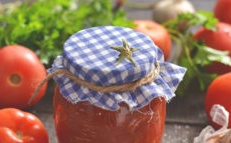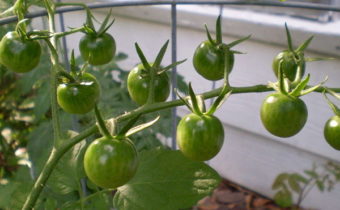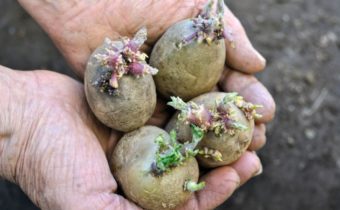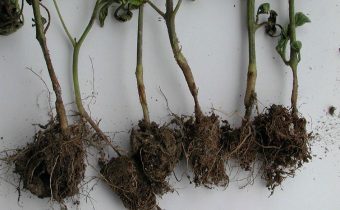What is the temperature tolerated by tomatoes?
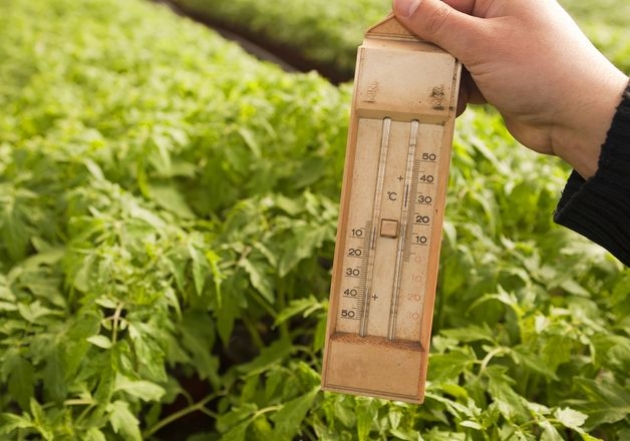
Tomato is thermophilic, creating comfortable conditions for growing seedlings is simple, but after planting in open ground there are difficulties. Planting is carried out from mid-May until the end of June, when the weather is more or less stable and warm during the day, but at night there can be a sharp cooling. What temperature will the culture withstand in the open field, what consequences does the temperature violation entail, how to solve the problems encountered during periods of cold snap at night? Let's discuss.
What temperature can tolerate tomatoes in open ground
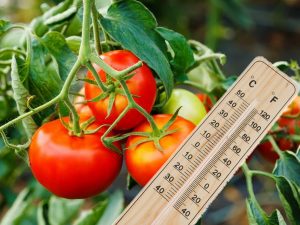 In gardeners there is no consensus about the resistance of the tomato to cold snaps. Some argue that picking up the right, hardy variety for open ground, the bushes will take a minus temperature from 4 to 6 degrees. But only under the condition of windless weather and short cooling, and no one can say for sure how long the tomatoes will stand. Others say that such a significant freeze will instantly lead to the death of the plant.
In gardeners there is no consensus about the resistance of the tomato to cold snaps. Some argue that picking up the right, hardy variety for open ground, the bushes will take a minus temperature from 4 to 6 degrees. But only under the condition of windless weather and short cooling, and no one can say for sure how long the tomatoes will stand. Others say that such a significant freeze will instantly lead to the death of the plant.
Practice and experiments of gardeners show that the permissible daytime temperature can be + 18-20 degrees with short-term decreases to +15. Under such conditions, tomatoes can tolerate nighttime cooling to +5 degrees without a critical slowdown in growth. Early ripening varieties do not suffer from a short-term (up to 3-5 hours) lowering the temperature to +3 or +4 degrees, they can bear fruit and fully mature even in a short, cool summer. Zero and sub-zero temperatures are detrimental to all varieties and hybrids.
Important!
Planting tomatoes in open ground is carried out when the air temperature rises to + 22-25 degrees during the day and up to +18 at night. It is precisely at such elevations that the correct development of the plant, the laying, the formation of ovaries and fruits is observed. Cold-resistant varieties can be planted when the night temperature does not fall below +10 degrees.
How does lowering night temperature affect tomatoes?
 You can not ignore the origin of the culture, it is a southern plant. Thanks to the work of breeders, it is adapted to our climate. But despite the weighty achievements of scientists, it is better not to take risks and not to test even super-resistant varieties for strength under extreme conditions.
You can not ignore the origin of the culture, it is a southern plant. Thanks to the work of breeders, it is adapted to our climate. But despite the weighty achievements of scientists, it is better not to take risks and not to test even super-resistant varieties for strength under extreme conditions.
If the bushes suffered a strong decrease in temperature (less than +10 degrees at night), they look healthy, it does not mean that the processes responsible for the growth and development of tomato are not disturbed. The problem may appear a little later, sometimes the consequences are really dire.
Possible risks:
- first of all, growth slows down, and if the temperature stays within + 10–12 degrees at night for several days, the bushes will generally stop growing;
- at low temperatures, pollination does not occur, this is especially noticeable when it is cloudy during the day;
- when the night temperature drops to 0, the flowers in the tomatoes fall off, if the leaves and stems begin to die below;
- tomatoes, which are constantly exposed to cold, weaken, immune to diseases falls sharply.
We will not ignore the temperature of the soil. For normal development, the earth should be heated to + 20-22 degrees.When the temperature drops to +16, the assimilation of phosphorus and nitrogen by tomatoes is complicated, adventitious roots do not absorb moisture. Provided that the soil warms up only to + 10–12 degrees, the roots no longer absorb any food.

How to care for tomatoes when the temperature drops?
If in the region there are sharp temperature fluctuations in the first half of summer, then for planting tomatoes it is necessary to select a closed, windless area on the south side of the vegetable garden, where there is no shadow. Soil moisture is also important, wetlands freeze through faster, which means that the ground should be loose and permeable.
Before planting build a framework for the hothouse - temporary shelter. First, it is intended to warm the soil, after planting to shelter tomatoes in dangerous periods. The frame can be metal or wood, and translucent polyethylene is used as a covering material. The height of the structure is calculated taking into account the characteristics of tomato varieties; it is important that the covered plants do not abut against polyethylene, otherwise they will freeze.
With the threat of severe cooling, the film is placed on the arc in 2 or 3 layers, it is desirable to throw blankets, roofing material, old things or other rags from above. For the temporary shelter of individual bushes, you can build individual caps of paper or roofing material, the second material accumulates heat for the day, and gives it to plants at night. On large plots with tomatoes, they are warmed with fires, spread around the beds.
Important!
Garden beds must be mulched. A layer of dry grass, straw, sawdust or peat protects the soil not only from drying, but also keeps the heat accumulated during the day.
General tips:
- the first watering of tomatoes in open ground is carried out during planting, the next after 5 or even 10 days. Water is used only warm (heated from the sun), watering is carried out exclusively at the root. If the soil is wet and it rains, watering is not done at all;
- the shelter is usually only needed at night, during the day the tomatoes are opened, but when the daytime temperature does not rise above 15 degrees, the tomatoes are left under the film;
- very young seedlings, with the threat of night frost, you can spud whole soil or mulch, then remove the shelter.
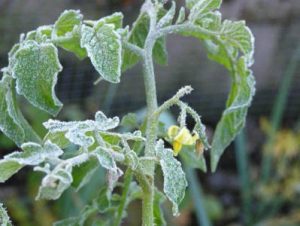 If you did not have time to follow the weather forecast and did not cover tomatoes in time, which led to freezing of small bushes, do not despair, you can still save them, but you need to act quickly. The ability to restore laid the culture at the genetic level. How to help tomatoes recover:
If you did not have time to follow the weather forecast and did not cover tomatoes in time, which led to freezing of small bushes, do not despair, you can still save them, but you need to act quickly. The ability to restore laid the culture at the genetic level. How to help tomatoes recover:
- first of all watering the beds, then all the affected parts bush pruned to healthy tissue, often have to cut the entire bush to ground level. Tomatoes will grow from dormant buds (at the base of the leaf or at the root). The beds are covered from the sun, in order to avoid additional burns;
- bushes need water fertilizer, you can use urea, infusion of bird droppings or potassium humate. In general, humates help restore the root system of plants affected by frost;
- Now you need to conduct foliar sub-food, in such cases use Appin (1 ampoule per 5 liters of water), Tsitovit or Zircon 1 ml per bucket of water. Treatments are carried out 1-2 times a day, in the morning or in the evening;
- The first 7 days the tomatoes are left under the film, then the covered ones are removed, first for a couple of hours and gradually increase the time.
Tomatoes are restored fairly quickly, with proper further care you can get quite a good harvest, but a couple of weeks later than expected.
How to improve the cold resistance of tomatoes?
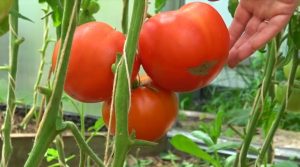 Frost tomato can be improved even at the stage seed preparation for sowing. Quenching of pre-germinated seeds is carried out at a temperature of from -2 to +2 degrees, for this purpose they can be placed in the refrigerator, but not more than 2 days.
Frost tomato can be improved even at the stage seed preparation for sowing. Quenching of pre-germinated seeds is carried out at a temperature of from -2 to +2 degrees, for this purpose they can be placed in the refrigerator, but not more than 2 days.
Before planting seedlings in open ground, young plants are also hardened. Begin the procedure 10 or 14 days before the scheduled disembarkation date.The temperature is gradually reduced to 10-15 degrees. Bushes can be transferred to the loggia or open a window in a room with seedlings, first for 5 minutes and gradually increase the time. 3 or 4 days before planting, tomatoes begin to be carried out onto the street, first they are put in the shade and gradually moved to the sun. At night, seedlings are left on the street just before planting.
Before and after planting tomatoes, be sure to follow the weather forecast, do not transfer seedlings to open ground before the recommended time limit, and do not be lazy to cover the beds during dangerous periods. Tomatoes that have suffered from the cold can be saved, but then you have to sacrifice a part of the crop, add yourself extra care. Do not forget about the preferences of the culture, create the most favorable conditions for it and no problems for tomatoes will be terrible!


